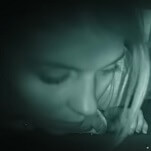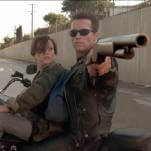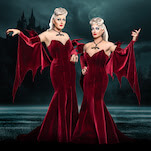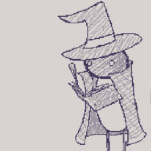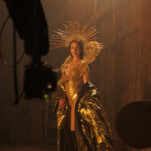Each week, Big Issues focuses on newly released comic books of significance. This week, they are Wonder Woman #35, written by Brian Azzarello with art by Cliff Chiang, and Sensation Comics #3, written by Sean E. Williams, Ollie Masters, and Gilbert Hernandez with art by Marguerite Sauvage, Amy Mebberson, and Hernandez. These two issues spotlight the compassion and strength that have made Wonder Woman a feminist icon, revealing the multiple dimensions of DC’s flagship superheroine in the process. (Note: This review reveals major plot points.)
“Not even girls want to be girls so long as our feminine archetype lacks force, strength, and power. Not wanting to be girls, they don’t want to be tender, submissive, peace-loving as good women are. Women’s strong qualities have become despised because of their weakness. The obvious remedy is to create a feminine character with all the strength of Superman plus all the allure of a good and beautiful woman.” – William Moulton Marston, The American Scholar (1943)
Wonder Woman is a deeply complex superhero. As the above quote from the character’s creator demonstrates, she was intended to be a role model for young women, showing them that they can have the might and confidence typically associated with men, but also embody traditional feminine values of compassion and pacifism. Marston believed that women would experience a dramatic rise to power after World War II brought an influx of women in the workforce, and Wonder Woman was his way of preparing young girls for a world where they would be given more responsibility than ever before.
Submission was an essential part of the Wonder Woman formula, and while there’s certainly an element of kink—the character is constantly getting tied up while wearing a skimpy costume inspired by the dress of 1940s pin-up girls—that erotic element served a larger political philosophy. The heroine was bound in ropes and chains, which represented the impulses that keep women submissive in a male-dominated society—war, hate, greed, lust for power, etc.—and breaking through those restraints was a key visual representation of a woman’s ability to overcome those social limitations. On the flip side, the bondage of men by Wonder Woman’s golden lasso of truth was specifically intended to arouse male readers so that they would have positive associations with submission to a loving female figure, even if that association was rooted in erotic sensation.
The political importance of Wonder Woman is detailed in Jill Lepore’s new book, The Secret History Of Wonder Woman, which delves into Marston’s significant connections to the feminist movement as well as Wonder Woman’s role as a savior of superhero comics. The debut of Superman coincided with the rise of the Nazis in Europe, and superhero comics came under fire because of a widespread fear that an idealized fascist ubermensch would have a negative impact on the impressionable minds of American children. To help quell the anger of paranoid parents, Superman publisher M.C. Gaines reached out to Marston after reading a piece in Family Circle detailing how comics could be beneficial to kids, a piece written by Marston’s mistress, Olive Byrne (who also happened to be the niece of birth control activist Margaret Sanger). Marston suggested introducing a female hero, countering the violent masculinity of male superheroes with a kind, loving, beautiful woman.
And love is Wonder Woman’s ultimate aim. Her actions and her character traits all serve that ideal, and that’s made her an invaluable addition to superhero comics. No matter how strong Wonder Woman becomes—and making the character the daughter of Zeus in the New 52 has dramatically increased her power levels—her capacity for love will always be her defining attribute, and the best runs on the Wonder Woman title have understood the importance of this personal quality.
This week, writer Brian Azzarello, artist Cliff Chiang, colorist Matthew Wilson, and letterer Jared K. Fletcher depart DC’s Wonder Woman series after three years of exceptional stories, and their final issue, #35, is a satisfying conclusion that doesn’t shy away from the complexity of Diana’s character. Their run was full of atmospheric horror, Jack Kirby-inspired bombast, and mythology-fueled fantasy, but in the end it’s all about showing just how far Diana will go for love. But not romantic love. Readers who want to see Diana as a girlfriend can find it in Superman/Wonder Woman, but that aspect of the character’s life never made its way into Azzarello’s refreshingly self-contained story.
Azzarello’s story is about Diana’s love for herself. It’s about her love for her best friend Zola and her half-brother Zeke. It’s about her love for her mother and the rest of the Amazons, and her love for the dysfunctional extended family of gods she gains after learning the truth about her conception and her father’s identity. In this final chapter, Diana faces off against the maniacal First Born for the last time, and she loves him, too. But not all love is about being gentle. Sometimes you need to be firm and assertive with someone you care for, and Diana is able to stop the First Born by showing tough love in hopes that one day he’ll learn his lesson, even if it takes another 7,000 years of imprisonment.
In a moment that perfectly encapsulates the central ideals of the character, Diana attacks the First Born and binds him in her golden lasso while outlining the reasons why the villain’s plan has been flawed from the start. “You scream for love, First Born, yet you know nothing of it. Love requires compassion, nurturing, and above all, submission.” Later, she goes into further detail regarding that last part, clarifying that “submission is faith in the strength of others.” Azzarello’s take on Wonder Woman has been dramatically different from past interpretations of the character—and a lot of fans have been turned off by the changes made to her origin and the backstory of the Amazons—but this final issue reveals that the writer has a clear understanding of Diana’s philosophical roots.
Over the last three years, Azzarello and Chiang have delivered a take on Wonder Woman that feels like a natural evolution of the character introduced more than 70 years ago. Chiang’s interpretation of Diana is supermodel gorgeous, but his artwork has never been exploitative. His Wonder Woman fits a traditional idea of feminine beauty, but her representation on the page always emphasizes strength rather than physical attractiveness. Chiang makes a conscious effort to avoid cheesecake poses and gratuitous T&A, treating all the female characters in Wonder Woman with the same respect regularly given to male figures. All it takes is one look at the cover of Wonder Woman #35 to see Chiang’s immense skill for drawing diverse female characters, and Azzarello’s story gave him the opportunity to flex those muscles by filling the plot with captivating women.
In addition to the finale of the first New 52 Wonder Woman run, this week also sees the release of Sensation Comics #3, the latest installment in the anthology series that reprints stories that are digitally released each week. DC’s recent anthologies for Superman and Batman have had great success by allowing a diverse group of creators to tackle signature superheroes without any continuity restraints, and that strategy has made Sensation Comics one of the best places for accessible Wonder Woman stories.
Two of the stories in this week’s printed edition of Sensation Comics are currently available digitally, and one is extremely relevant to events of the past week. Written by Sean E. Williams with sleek, stylish artwork by Marguerite Sauvage, “Bullets And Bracelets” imagines Wonder Woman as a modern rock star, replacing the thrill of a superhero battle with the exhilaration of a live concert. It’s a change that puts Diana’s character in a more grounded context, which is further emphasized by her struggle with something ordinary women have to deal with on a regular basis: street harassment.
A YouTube video detailing 10 hours of sexual harassment endured by a woman walking the streets of New York City went viral this week, drawing attention to another way women suffer harassment that men rarely, if ever, experience. (Another example has been in the news a lot lately: online abuse.) While leaving her latest gig, Diana encounters two men arguing about the way she’s dressed; one man calls her a slut who is corrupting the world’s children, while the other one praises her appearance because he finds it sexually attractive. Diana’s response is a sentiment that has been echoed by a lot of women over the past week: “I hate to break it to you both, but I dress this way because I want to, not to provoke or impress you.”
Later, Diana has another run-in with the man who praised her beauty, who apologizes for what he said but justifies it by telling her that she’s “really hot.” Diana’s response? “If I wanted to know your opinion, I’d ask for it.” And when he grabs her arm, Diana gets even more aggressive: “Don’t ever touch me without my permission, friend.” The threat of violence prevents a lot of women from reacting this way in real life, and sure enough, Diana’s pursuer doesn’t take her rejection well, pulling a shotgun out of the back of his car and pointing it at Diana and her two young girl companions.
Diana bends the barrel and sends the man running in terror, and the script ends with the character vowing to make America a “citadel of democracy and equal rights for women.” It’s a loaded story considering it’s only eight pages long, and it’s great to see Wonder Woman tackle an important social issue that directly affects women. Perhaps most importantly, it teaches male readers that they need to respect women, blatantly explaining that females aren’t objects of sexual desire, but human beings that have personal boundaries that shouldn’t be impeded on.
Sensation Comics #3 also features a delightful tale by writer Ollie Masters and artist Mebberson that spotlights another reason why Wonder Woman is such a distinct superhero: her connection to the realm of mythological fantasy. Selina “Catwoman” Kyle has come to London to steal the legendary Golden Fleece, but she needs Diana’s help if she’s going to successfully complete her mission; the fleece is protected by a flame-spitting dragon, and Selina tricks Diana into fighting the mystical guardian while she runs off with the loot. It’s a light, fun story with bright artwork from Mebberson (who does particularly remarkable work realizing Darwyn Cooke’s iconic Catwoman design), and Masters’ script mines humor from the Diana/Selina dynamic while showing how easy it is to throw Diana into a superheroic situation by turning to mythology.
The final story of Sensation Comics #3 is written and drawn by alt-comics visionary Gilbert Hernandez with colors by John Rauch, and his story is the purest representation of Marston’s vision out of all this week’s Wonder Woman stories. Titled “No Chains Can Hold Her!”, the short comic is heavily influenced by the tone and visual style of Wonder Woman’s Silver Age appearances, pitting Diana against the forces of Kanjar Ro, the alien dictator who wants to make her his zombie slave because she’s “a symbol of strength and courage that those other worlds have never known.”
The villains of the piece are misogynists that plan their strategy around the belief that women are easily distracted by flattery, and when Supergirl comes to Wonder Woman’s rescue, they brush her off because she’s “just another easy Earth girl.” To help emphasize the idea that this is a long-lost chapter in Wonder Woman’s history, the plot ends on a cliffhanger that will likely never be resolved, but it’s obvious the aliens underestimate these “Earth girls” because Wonder Woman and Supergirl survive their extraterrestrial encounter and go on to have all kinds of Silver Age superhero adventures.
Like Chiang, Hernandez’s interpretation of Wonder Woman focuses on strength above all else, exaggerating her bulging biceps and thick thighs to present a version of the character that has more in common with a bodybuilder than a pin-up girl. Even without her mystical power, it’s easy to see Hernandez’s Wonder Woman shattering any chains that bind her, and Supergirl looks downright puny compared to Diana.
All the different interpretations of Wonder Woman this week—Azzarello and Chiang’s compassionate demigod, Williams and Sauvage’s badass rock star, Masters and Mebberson’s urban fantasy warrior, and Hernandez’s hulking sci-fi heroine—reveal the versatility and virtue that have made Diana’s DC signature female superhero. Wonder Woman is about to experience a big profile boost with her upcoming big screen appearances in Batman V Superman: Dawn Of Justice and her own solo film in 2017, and as the character makes the transition to a film universe that hasn’t been heavily associated with love and compassion, hopefully Warner Bros. and DC Comics won’t forget about the fundamental characteristics that have made this week’s stories so memorable.











